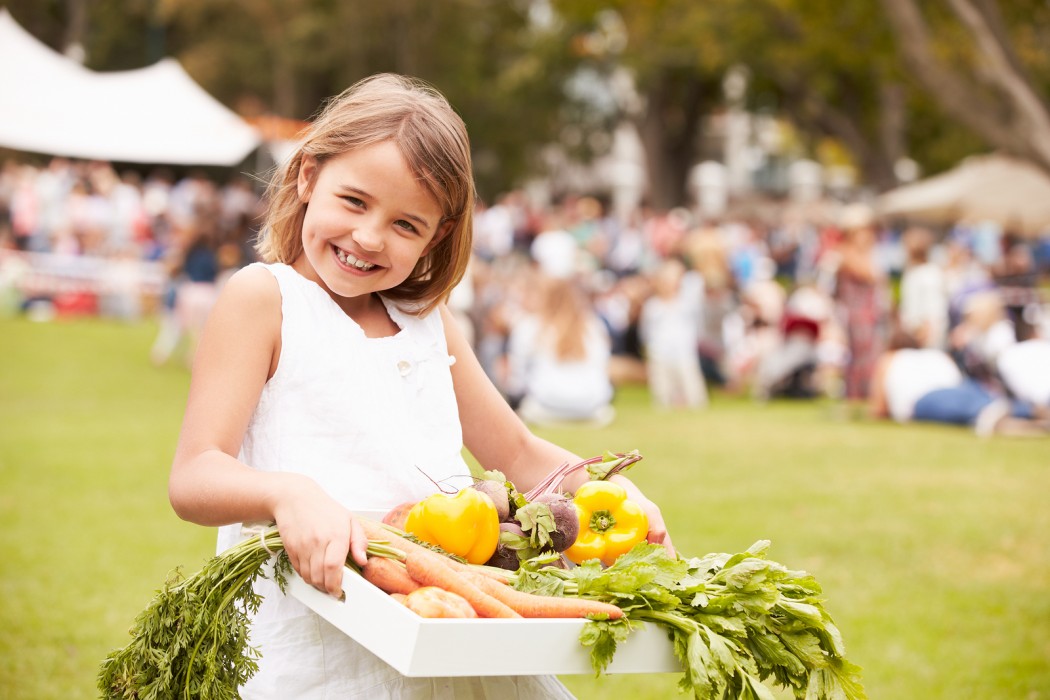Taking a trip to your local farmer’s market is a great way to treat your family to some fantastic seasonal produce and to discuss a number of topics with your kids, from food sourcing to the environment. During the early weeks of summer, the farmer’s market is at its most colorful: loads of seasonal fruits and vegetables, herbs and flowers, fresh eggs, cured meats, and locally produced honey — and usually tons of tasty fresh baked treats! There is a lot for children to take in and numerous opportunities for them to learn by participating.
7 Things Kids Can Learn at the Farmer’s Market
1. Our environmental impact.
When you go to a farmer’s market, you need to BYOB — bring your own bag, that is. If this is your child’s first trip to the market they will typically ask why. This a great opportunity to explain that unlike the grocery store, farmer’s markets don’t provide plastic or paper bags that are thrown away and end up in landfills. Bringing reusable bags helps the environment and also saves money for the businesses. Even buying from local farmers helps the environment, because food isn’t shipped and trucked in from other states or countries.
2. The difference between processed and unprocessed foods.
At a child’s first trip to the farmer’s market, they are likely to find few processed foods, foods in colorful packaging, boxes, and bags. The “processed” foods and items that are available are small-batch and scratch-made. If they ask where the cereal aisle is, you can point out the difference between the food at the farmer’s market and the convenience foods you purchase when you’re at the grocery store.
3. The names of different fruits and vegetables.
Your children might see fruits and vegetables they’ve never seen before, or noticed during a hectic Saturday morning trip to the grocery store. This is a chance to let your kids ask questions of the vendors (“What does it taste like?”), touch, smell, and learn about produce. Also, if they know the name, they’ll be more likely to try it and can ask for it.
4. What goes into making a meal.
Getting your kids involved in the kitchen is a great way to get them try new foods. It’s easier said than done, with busy schedules and hectic nights you likely want to get into the kitchen, cook dinner, feed them, clean up, and put an end to your day. If you’re going to a farmer’s market on the weekend, you could plan (and mentally prepare) to have everyone help out in the kitchen that night. Even if it’s just letting them dress and and toss a salad with a few of the veggies they picked out from the market that day. We’re willing to bet they’ll give it a try once they’ve had a hand in preparing it.
5. Different types of farming.
A trip to the farmer’s market is a great chance for kids (and adults!) to learn about different types of farming and often gives everyone a chance to ask questions of the farmers themselves. Explain the difference between organic and natural and why some farmers need to use pesticides on highly prone plants and why that impacts the cost so greatly.
6. Seasonal food.
If your child is wondering where the butternut squash and pineapples are, you can dive into what seasonal, local food is. The food that is offered at farmer’s markets is only what can be grown in your region during a specific time of year. The supermarkets have a wide variety of produce because they have it shipped or trucked in from different parts of the country or the world.
7. The importance of community.
Along with explaining the concept of local food, you could also take this opportunity to talk to your children about why it’s important to support businesses and people in your community. That it’s difficult for small, local farmers to compete with large supermarket chains and you try to support them when you can — even if it’s just a few times a year. If your children are old enough, you can give them a small allowance (farmer’s markets are typically cash-only) and let them purchase their own food, count their money, and “contribute” to their local economy.
For more ideas for fun activities for kids, visit Angelibebe at https://www.angelibebe.com/blog/.
